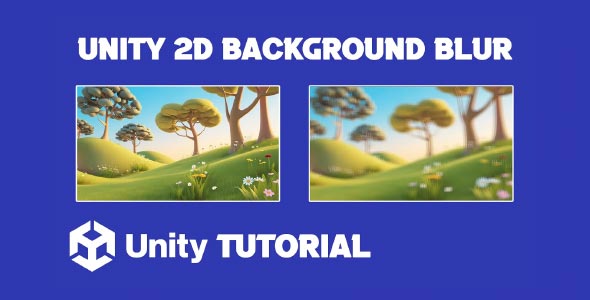Blur background Unity 2D effect is one of those small visual touches that can greatly improve the polish and clarity of your game. Whether you’re designing a settings menu, a pause screen, or a dialogue window, having the background blur slightly can help direct the player’s focus to the foreground without fully disconnecting them from the scene. It adds a layer of visual depth and makes the user interface feel more modern and intentional.
In 2D games especially, where screen space is limited and multiple elements often share the same canvas, blurring the background helps isolate what’s important. It allows your menus or popups to stand out while still giving players a subtle sense of what’s happening behind them. This kind of effect has become increasingly popular in both indie and professional game development, and it is now widely considered a best practice in UI and UX design within games.
Unity Background Blur Shader
A commonly used method to achieve this effect is through a Unity background blur shader, which acts directly on the visual layers behind your interface. This approach allows for smooth performance while delivering a strong visual result, and it works particularly well in 2D games where rendering efficiency is crucial.
In practice, a shader-based blur modifies how the background is visually processed without altering the game logic or scene layout. This means your characters, environment, and active gameplay elements remain untouched in terms of functionality but appear soft and out of focus visually. The benefit here is twofold: not only do you preserve the underlying gameplay, but you also create an elegant visual separation between the background and UI.
Another key reason many developers prefer a blur shader is the level of control it offers. You can adjust the blur intensity, selectively apply it to specific objects or layers, and even animate the transition for a more dynamic effect. This flexibility allows you to tailor the blur to your game’s tone and visual style, whether that’s minimal and clean or rich and atmospheric.
Unity Blur Effect UI
When talking about blurring backgrounds in UI design, it’s impossible not to focus on the Unity blur effect UI approach. This technique is widely used in menus, dialogue panels, inventory systems, and cutscenes to create visual hierarchy and improve user attention.
The main goal of a blur UI setup is to keep players immersed in the scene while making the user interface more readable. Instead of cutting away to a completely different screen or removing the game world entirely when a menu opens, you softly transition the background to a blurred version. This helps reduce cognitive load by maintaining visual context, which in turn improves the overall player experience. The blur background Unity 2D effect is especially useful for achieving this smooth transition while keeping the scene visually cohesive.
Using blur in the UI is especially powerful for mobile or smaller screen games where space is at a premium. A full-screen UI can feel overwhelming or disconnected from the game. Blurring solves this by keeping the scene present, but subtly muted, letting the UI pop without adding more noise or complexity.
This effect also pairs well with other techniques like darkened overlays, color tinting, or subtle scaling, all of which can work together to highlight the UI elements and create a premium visual feel.
Why Blurring Matters In Unity 2D Games
Going back to the importance of the blur background effect, it’s easy to see why this has become a go-to solution in 2D game design. The 2D space can quickly become cluttered with sprites, characters, and objects all competing for attention. When you add in UI elements like health bars, menus, or quest logs, the need for visual separation becomes even more apparent.
Blur allows you to manage this complexity without removing content. It offers an elegant way to prioritize visual elements, drawing attention where it matters most. A background that gently fades into softness can make a crisp UI element appear sharper and more defined, improving both aesthetics and usability.
It also helps build emotional tone. A blurred background can create a sense of calm, focus, or transition. It softens harsh lines and brings a cinematic quality to scenes that might otherwise feel static. And because it’s non-intrusive, it’s a subtle addition that enhances rather than distracts. The blur background Unity 2D effect is perfect for achieving this atmosphere, adding depth without overwhelming the visual design.
Blur Effect Unity 2D
Revisiting the topic of Unity background blur shader, it’s worth noting that performance is always a concern in game development. Applying visual effects in real time can impact frame rate, especially on lower-end devices or mobile platforms. A well-optimized blur shader addresses this concern by targeting specific render layers or using downsampled versions of the scene to reduce processing load.
In many cases, blur is not applied globally but only to parts of the screen behind UI panels or windows. This helps retain game performance while still achieving the desired visual outcome. Choosing the right blur strength and selectively applying it is key to maintaining balance between aesthetics and speed. An effective Unity blur effect UI strikes the right balance between visual appeal and system efficiency, making sure the interface feels smooth without putting extra strain on performance.
Another benefit is visual cohesion. Blur shaders often come with settings for color blending, edge softness, and even animation curves that can match your game’s visual identity. When implemented correctly, these shaders make UI transitions feel intentional, smooth, and integrated into the overall look and feel of the game.
Unity 2D Blurring Effect
Turning again to blur UI, the design decisions you make can significantly impact user satisfaction. Players interact with menus and UI elements constantly, so how those elements appear and behave plays a big role in the overall experience.
By integrating blur into your UI flow, you allow smoother transitions between gameplay and interface. Players don’t feel like they’re jumping between different environments or disconnected screens. Instead, it all feels like part of one seamless system.
Blur can also act as feedback. For example, during a pause, menu, or inventory check, the background blur communicates to the player that the action is paused or temporarily suspended. It sets a mood and makes your game feel more polished and complete.
Moreover, blur in UI design can be accessible. For players with vision difficulties or sensitivity to motion, a static blurred background can be more comfortable than hard cuts or bright overlays. When used with proper contrast and clean typography, it creates a UI that is both beautiful and functional.
Conclusion
Incorporating the blur background Unity 2D effect into your game is a simple but powerful way to enhance visual quality, focus attention, and improve the overall player experience. Whether used in menus, dialogue boxes, or cutscenes, this effect adds depth and clarity without overwhelming the screen.
By using tools like the Unity background blur shader, you gain technical flexibility and artistic control, making it easy to adjust blur levels, create smooth transitions, and ensure consistent performance. It’s a practical solution that scales across project sizes and target platforms.
And through thoughtful use of Unity blur effect UI techniques, you can elevate your game’s interface design, guiding players’ focus, maintaining immersion, and creating an intuitive, elegant user experience. Blur is more than just a visual flourish — it’s a key element in making your game feel polished, immersive, and professional.
Shader Code:
Shader "Custom/SimpleBlurShader"
{
Properties
{
_MainTex("Base (RGB)", 2D) = "white" {}
_BlurSize("Blur Size", Float) = 1.0
}
SubShader
{
Tags { "Queue" = "Overlay" }
Pass
{
CGPROGRAM
#pragma vertex vert
#pragma fragment frag
#include "UnityCG.cginc"
struct appdata_t
{
float4 vertex : POSITION;
float2 uv : TEXCOORD0;
};
struct v2f
{
float4 pos : POSITION;
float2 uv : TEXCOORD0;
};
sampler2D _MainTex;
float _BlurSize;
v2f vert(appdata_t v)
{
v2f o;
o.pos = UnityObjectToClipPos(v.vertex);
o.uv = v.uv;
return o;
}
half4 frag(v2f i) : SV_Target
{
half4 color = half4(0,0,0,0);
float2 uv = i.uv;
// Calculate the offset based on blur size
float blurSize = _BlurSize * 0.01;
// Apply a simple 3x3 box blur
color += tex2D(_MainTex, uv + float2(-blurSize, -blurSize)) * 0.111;
color += tex2D(_MainTex, uv + float2(0.0, -blurSize)) * 0.111;
color += tex2D(_MainTex, uv + float2(blurSize, -blurSize)) * 0.111;
color += tex2D(_MainTex, uv + float2(-blurSize, 0.0)) * 0.111;
color += tex2D(_MainTex, uv) * 0.111;
color += tex2D(_MainTex, uv + float2(blurSize, 0.0)) * 0.111;
color += tex2D(_MainTex, uv + float2(-blurSize, blurSize)) * 0.111;
color += tex2D(_MainTex, uv + float2(0.0, blurSize)) * 0.111;
color += tex2D(_MainTex, uv + float2(blurSize, blurSize)) * 0.111;
return color;
}
ENDCG
}
}
Fallback "Diffuse"
}Script: BlurController.cs
using UnityEngine;
using UnityEngine.UI;
public class BlurController : MonoBehaviour
{
public SpriteRenderer spriteRenderer; // Assign in Inspector
public Material blurMaterial; // Assign in Inspector
public Material originalMaterial; // To store the original material
void Start()
{
if (spriteRenderer != null)
{
originalMaterial = spriteRenderer.material;
}
}
public void ApplyBlur()
{
if (spriteRenderer != null && blurMaterial != null)
{
spriteRenderer.material = blurMaterial;
}
}
public void RemoveBlur()
{
if (spriteRenderer != null && originalMaterial != null)
{
spriteRenderer.material = originalMaterial;
}
}
}Blurring the background in a Unity 2D project can help draw attention to UI elements or focused gameplay areas, such as menus, dialogue boxes, or pause screens. There are a few different methods to achieve this, including using shaders or camera effects. If you’re looking for a step by step approach to applying blur in various scenarios, this Blur Effect Unity 2D Tutorial offers a detailed guide that covers different techniques suited for both beginners and intermediate users.


